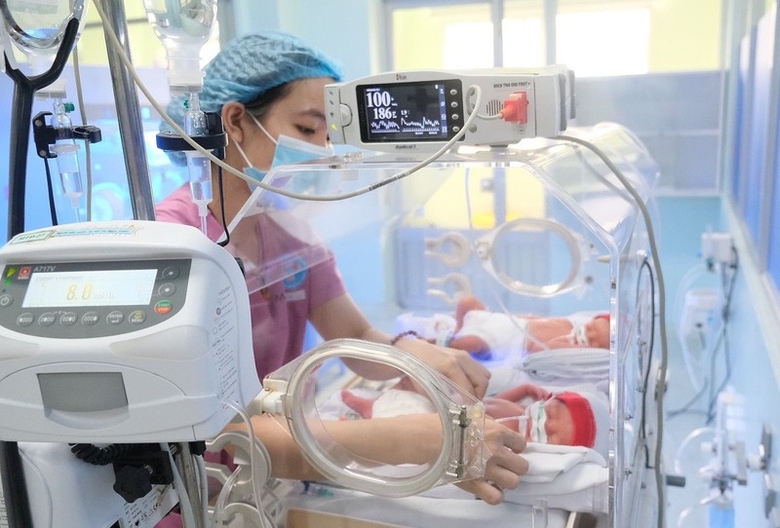
Risk of negative population growth
The Ministry of Health has just proposed intervention solutions to maintain replacement fertility in Vietnam and prevent negative population growth.
In our country, the average population growth rate in the period 2017 - 2020 is 1.07%. However, due to the slight decrease in fertility, the population growth rate has gradually decreased in recent years (the average population growth rate in 2022 is 0.98%, in 2023 is 0.84%) and is forecast to continue to decrease in the following years. According to the Vietnam Population Forecast 2019 - 2069 of the General Statistics Office, in the case of a sharp decrease in fertility as in the low scenario, after 2054, our country's population will begin to grow negatively and the population decline will become larger and larger. In the period 2054 - 2059, the average population decline is 0.04% per year, this decline at the end of the forecast period (2064 - 2069) is 0.18%, equivalent to an average decrease of 200,000 people/year. On the contrary, if the replacement fertility rate remains stable, Vietnam's population will increase slightly, with an average increase of 0.17% per year in the period 2064 - 2069, equivalent to 200,000 people/year.
According to the Department of Population (Ministry of Health), Vietnam's current fertility pattern has shifted from the highest birth rate in the age group of 20-24 to the age group of 25-29, while the age of marriage has increased and the marriage rate has decreased. This shows that the trend of late marriage, not wanting to marry, not wanting to have children, giving birth late, having few children, and having few children is increasing and spreading.
Mr. Le Thanh Dung, Director of the Population Department, said that studies and forecasts show a trend of declining birth rates in Vietnam. This trend, in addition to the impact on population size, also leads to a decrease in the proportion of children under 15 years old and an increase in the proportion of the elderly. Vietnam is still in the process of population aging and is one of the countries with the fastest aging rate in the world. It is forecasted that by 2038, which means only 15 years from now, our country will enter the period of aging population, meaning that for every 5 people, there will be one person over 60 years old.
Need policy leverage
According to Dr. Bui Chi Thuong, Gia Dinh People's Hospital (Ho Chi Minh City), the recent proposal by the Ministry of Health to let couples decide how many children to have is completely reasonable in the context of Vietnam's rapidly aging population. This proposal should even be made sooner because the current population situation is that people are not rich but already old. At the same time, the birth rate in urban areas is alarmingly low, typically in Ho Chi Minh City, the birth rate in 2023 is only 1.32 children.
According to financial expert, Associate Professor, Dr. Ngo Tri Long, the Government needs to have more support policies to encourage having two children, such as support for renting houses, buying social housing (with preferential interest rates), or policies on education and health care to help young people reduce pressure, prepare mentally and in conditions to proactively have children. If there is no solution soon, we will face the risk of losing the abundant young labor force, will not be able to attract FDI enterprises, as well as large corporations in the world. Thus, the economy will face a labor crisis.
According to Professor Giang Thanh Long, Faculty of Economics, National Economics University (Hanoi), although the current replacement fertility rate in the country is not at an alarming level, there still needs to be policies to "anticipate". The important thing is that social security policies must ensure child-rearing so that couples can feel secure in having children.
Professor, Dr. Giang Thanh Long said that we are gradually implementing strategies and policies to adapt to population aging, so of course the elderly will be the focus of these strategies and policies. When talking about the elderly, it is important to note that there are two groups: the current elderly and the future elderly (or the young and middle-aged people now). Adapting to an aging population means preparing for both of these groups. On the other hand, for the younger population - the future elderly - it is necessary to take advantage of the "golden opportunity" when the proportion and number of this group will increase in about two decades. Prepare economically/financially, health and community activities to ensure both current and future income security and prepare for the "tripod" of active aging - ensuring the economy; ensuring health and community activities.
The Ministry of Health is also proposing policies on training and career transition for the elderly to adapt to population aging and an aging population. This is one of the notable points in the draft Population Law developed by the Ministry of Health that is being consulted. Accordingly, the country currently has more than 4 million elderly people working in the economy, but most of them are doing vulnerable jobs and have low incomes, with nearly 80% of elderly workers being self-employed and household workers. The average salary of the elderly is nearly 3.8 million VND/month, only 34% of the average salary in the market. The Ministry of Health proposes to develop solutions to adapt to the process of population aging and an aging population; to meet the basic needs of elderly care and some basic needs of the elderly that are increasing rapidly. However, to implement this solution, the Ministry of Health believes that the State needs to ensure a budget for propaganda and mobilization and to develop and issue detailed regulations and implementation instructions.
It should be emphasized that the elderly are not a “burden” on society, but they are still contributing their efforts - silently and often unrecognized - to their families, communities and society. Knowing how to make appropriate use of the knowledge and experience of the elderly will bring great value to society. On the contrary, if we do not take care of and prepare to adapt to a rapidly aging population appropriately and at the right time, we will miss the “golden opportunity” of the current population as well as create a real “burden” in the future with nearly 30 million elderly people by the middle of this century.
Source







![[Photo] Visiting Cu Chi Tunnels - a heroic underground feat](https://vstatic.vietnam.vn/vietnam/resource/IMAGE/2025/4/8/06cb489403514b878768dd7262daba0b)












































































Comment (0)